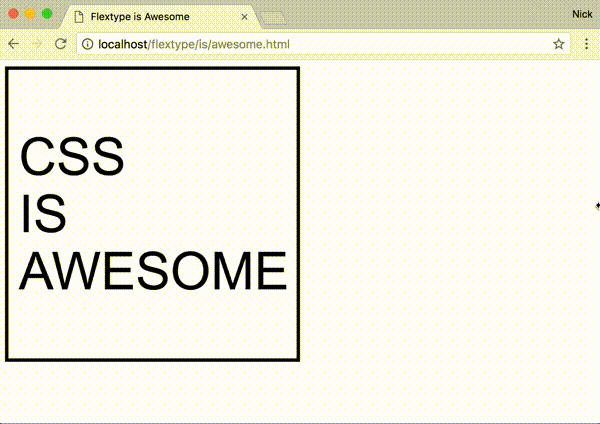Scale the font size of an element in proportion to its width... in style. 😎
- Simple syntax for scaling at different amounts for different widths
- Define your scaling ratios in CSS, allowing you to:
- easily override within media queries
- leverage whatever CSS-preprocessor variables you might be using for your site's layout and typography
- No dependencies
- Supports all modern browsers and IE9+[see caveat for IE/Edge]
npm install flextype --save<!-- Minified: -->
<script src="https://unpkg.com/flextype/dist/flextype.min.js"></script>
<!-- Un-minified: -->
<script src="https://unpkg.com/flextype/dist/flextype.js"></script>-
Add the class
js-flextypeto the element(s) you want to scale.<div class="MyElement js-flextype">Hello</div>
-
In CSS set the percentage of the
.js-flextypeelement's width you want the font size to be on the CSS custom property--flextype. For instance, if you want the font size to be18pxwhen the element is500pxwide and to scale linearly at that ratio, you would use the percentage3.6%..MyElement { width: 30%; float: left; /* ... */ --flextype: 3.6%; }
The ratio passed to flextype can also be expressed as a key-value pair written in JSON, where the key is an element width (in pixels) and the value is the desired corresponding font size (in pixels).
.MyElement {
/* Use valid JSON wrapped in single quotes */
--flextype: '{ "500": 18 }';
}The font size can be made to scale at different ratios for different width-ranges, flextype will adjust the font size depending on which rules the element's width currently falls between.
.MyElement {
--flextype: '{ "500": 18, "1000": 22 }';
}Given those rules we can expect that, for example, when 250px wide .MyElement will have a font size of 9px and when 750px wide .MyElement will have a font size of 20px.
You can lock the font size in for particular width-ranges by using + and - modifiers on the width keys.
.MyElement {
--flextype: '{ "250-": 10, "500+": 18, "1000": "22" "1500+": 36 }';
}The +/- modifiers will prevent the font size from scaling until the next/previous rule becomes active, respectively.
Flextype also has a simple javascript interface, which for the most part you shouldn't have to interact with unless you want to do particularly custom stuff.
-
Manually force elements to scale outside of the window resize event
myElement.style.width = '300px'; flextype.flex();
-
Use a custom selector instead of
.js-flextypeconst flexer = flextype(document.getElementsByClassName('💪')); // Use flexer.flex() to manually scale should you need to // Use flexer.destroy() to remove the resize listener and reset the font
-
Execute code on an element whenever flextype finishes scaling it
myElement.addEventListener('flextype:changed', function() { // Cycle the hue every 12px change in font size const hue = ((parseFloat(this.style.fontSize) % 12) * 360) / 12; this.style.color = `hsl(${hue}, 100%, 50%)`; });
-
Get the suggested font size of an element based on its CSS rules and width
flextype.getElSize(myElement);
-
Set the font size based on CSS rules and width
flextype.setElSize(myElement);
-
Parse a set of rules against a width programmatically
flextype.size({ '500-': 10, 1500: 20 }, 1000); // = 15
CSS custom properties are supported in the latest versions of all the major browsers except IE and Edge. As a workaround flextype also accepts rules embedded in the ::before pseudo element's content property.
.MyElement::before {
content: '3.6%';
display: none;
}You can use the flextype PostCSS plugin to convert your --flextype declarations into this format for you while Microsoft catches up.
The font size of any .js-flextype elements will be scaled immediately when flextype.js is loaded and then again whenever the window is resized. However, if you insert a new .js-flextype element into the DOM after flextype has already initialized, or if you resize a flextype container outside of the normal window resize event, you'll need to manually trigger the resize with:
flextype.flex();Flextype bases the font size off the width of the js-flextype element. If the width of the js-flextype element is itself based off the font size of its content (as it is with inline elements, for example) it can't work.



